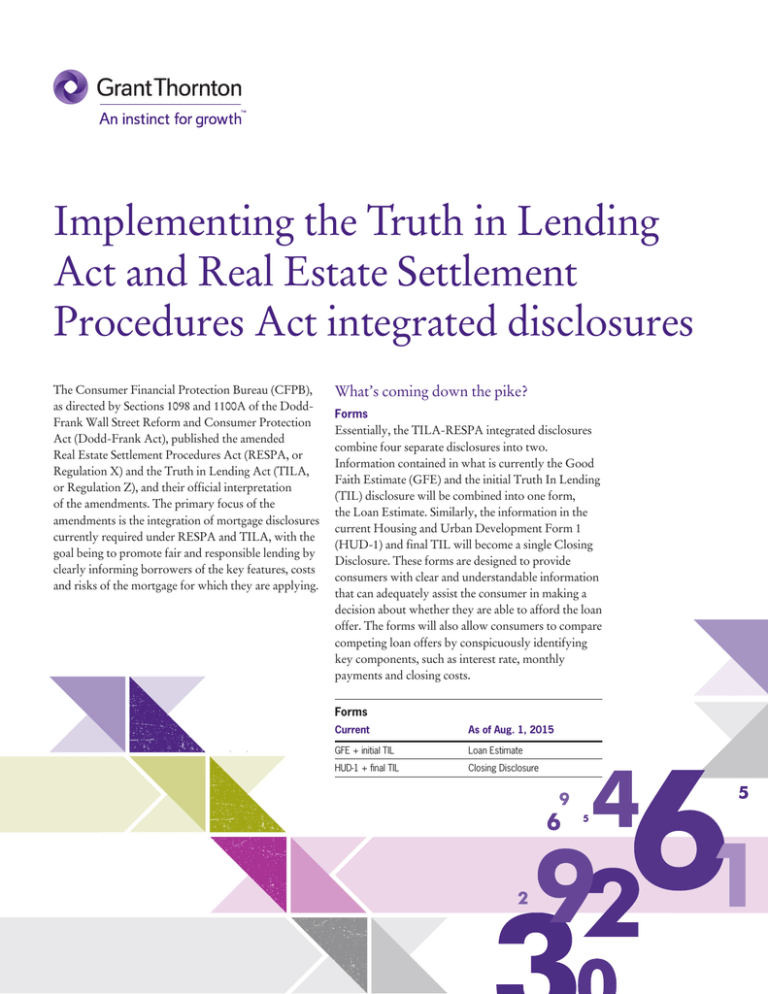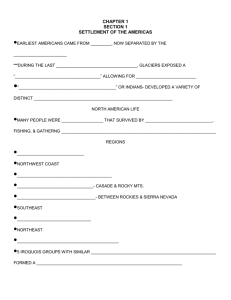
Implementing the Truth in Lending
Act and Real Estate Settlement
Procedures Act integrated disclosures
The Consumer Financial Protection Bureau (CFPB),
as directed by Sections 1098 and 1100A of the DoddFrank Wall Street Reform and Consumer Protection
Act (Dodd-Frank Act), published the amended
Real Estate Settlement Procedures Act (RESPA, or
Regulation X) and the Truth in Lending Act (TILA,
or Regulation Z), and their official interpretation
of the amendments. The primary focus of the
amendments is the integration of mortgage disclosures
currently required under RESPA and TILA, with the
goal being to promote fair and responsible lending by
clearly informing borrowers of the key features, costs
and risks of the mortgage for which they are applying.
What’s coming down the pike?
Forms
Essentially, the TILA-RESPA integrated disclosures
combine four separate disclosures into two.
Information contained in what is currently the Good
Faith Estimate (GFE) and the initial Truth In Lending
(TIL) disclosure will be combined into one form,
the Loan Estimate. Similarly, the information in the
current Housing and Urban Development Form 1
(HUD-1) and final TIL will become a single Closing
Disclosure. These forms are designed to provide
consumers with clear and understandable information
that can adequately assist the consumer in making a
decision about whether they are able to afford the loan
offer. The forms will also allow consumers to compare
competing loan offers by conspicuously identifying
key components, such as interest rate, monthly
payments and closing costs.
Forms
Current
As of Aug. 1, 2015
GFE + initial TIL
Loan Estimate
HUD-1 + final TIL
Closing Disclosure
Implementing the Truth in Lending Act and Real Estate Settlement Procedures Act integrated disclosures
Fee change tolerance
The amended regulations will also impose greater
restrictions on fee changes that occur between
the Loan Estimate and settlement. Currently, fees
listed on the initial TIL disclosure and GFE may be
increased on the final disclosures, within a tolerance
of 10%, unless they are lender-controlled fees. There
is zero tolerance for any change in fees that are under
the direct control of the lender between initial and
final disclosures.
Under the new RESPA requirements, lenders will be
prohibited from charging more for settlement services
than those already on the Loan Estimate for the
following: fees that they directly control, fees charged
by an affiliate of the creditor, fees charged by service
providers selected by the creditor and fees for services
for which the consumer is not permitted to shop. In
other words, if the borrower either does not have the
option to choose the third-party vendor for settlement
services or must select from a list of vendors, then the
creditor is said to have control over the corresponding
service fee and may NOT increase the fee at
closing, absent a change in circumstances. With the
implementation of this stringent standard, creditors
will have to take great care in preparing their initial
disclosures in order to ensure accurate estimates.
Fee increase tolerance level between initial disclosure and settlement
Tolerance level
Current
•
Fees that are in direct control of creditor (i.e.,
•
origination charge; while the borrower’s interest
rate is locked, the credit or charge for the interest •
rate chosen; while the borrower’s interest rate is
locked, the adjusted origination charge)
•
Transfer taxes
Fees that are in direct control of creditor
Fees charged for third-party settlement services
(i.e., title services, title insurance, survey,
pest inspection, recording fee, credit reports,
appraisals, flood checks, tax services and any
upfront mortgage insurance premium)
•
Recording fees
•
Charges for third-party services where the charge is
not paid to the creditor or the creditor’s affiliate
•
Charges for third-party services where the consumer
is permitted by the creditor to shop for the thirdparty service, and the consumer selects a third-party
service provider on the creditor’s written list of
service providers
•
Prepaid interest; property insurance premiums;
•
amounts placed into an escrow, impound, reserve
or similar account
Prepaid interest; property insurance premiums;
amounts placed into an escrow, impound, reserve or
similar account
•
For services required by the creditor if the creditor •
permits the consumer to shop and the consumer
selects a third-party service provider not on the
creditor’s written list of service providers
For services required by the creditor if the creditor
permits the consumer to shop and the consumer
selects a third-party service provider not on the
creditor’s written list of service providers
Zero tolerance
•
•
10% tolerance
No tolerance limitation
2
As of Aug. 1, 2015
Fees charged by third party affiliated with creditor
(service providers selected by the creditor; services
for which the consumer is not permitted to shop)
Transfer taxes
Implementing the Truth in Lending Act and Real Estate Settlement Procedures Act integrated disclosures
Consider the timing
The mandate for strict adherence to disclosure
timelines throughout the mortgage settlement process
is also important to consider. Currently, under TILA,
the creditor only has to provide the borrower with
a copy of the final TIL disclosure at least three days
prior to consummation only when the previously
disclosed annual percentage rate (APR) becomes
inaccurate. Additionally, unless the borrower requests
it, RESPA only requires that the settlement agent
complete the HUD-1 and make it available to the
borrower at or before the time of settlement. However,
the borrower does have the right to request a copy
of the HUD-1 statement one business day before
settlement and, if he does, it is the settlement agent’s
responsibility to provide this statement for inspection.
Settlement is defined by Regulation X as the “process
of executing legally binding documents regarding a
lien on a property that is subject to a federally related
mortgage loan.” See 12 CFR 1024.2(b).1
Timing requirements
Current
As of Aug. 1, 2015
Settlement agent must provide
final disclosures at or before
consummation
Creditor must provide Closing
Disclosure at least 3 days prior to
consummation
Must provide corrected
disclosures at least 3 days prior
to consummation when APR
changes
Must provide corrected
disclosures at least 3 days prior
to consummation when the APR
becomes inaccurate, the product
type changes or a prepayment
penalty is added
Consumer has the right to
request inspection of the HUD-1
one day before consummation
Consumer has the right to
request inspection of the Closing
Disclosure one day before
consummation
Beginning Aug. 1, 2015, creditors will have the
responsibility of providing consumers with the
Closing Disclosure at least three business days prior
to consummation in all instances. Consummation,
in contrast to settlement, occurs when a “consumer
becomes contractually obligated on a credit
transaction.” See 12 CFR 1026.2(a)(13).2 Additionally,
any changes to the Closing Disclosure when the APR
becomes inaccurate, the product type changes or a
prepayment penalty is added will require a revised
Closing Disclosure be sent to the borrower, along
with a new three-day waiting period.
1
U.S. Government Publishing Office, Real Estate Settlement Procedures Act – Regulation X, accessed March 3, 2015.
2
U.S. Government Publishing Office, Truth in Lending Act – Regulation Z, accessed March 3, 2015.
3
Implementing the Truth in Lending Act and Real Estate Settlement Procedures Act integrated disclosures
Key action items
Not only is the lender required and expected to have
a full compliance program ready to implement on
Aug. 1, 2015, but the CFPB also requires lenders to
remain in compliance with the current regulations for
any application submitted prior to that date as well. In
other words, the lender is not permitted to implement
the new regulation and corresponding forms prior to
Aug. 1, 2015. Practically, this means the lender must
have dual systems in place in order to account for
both the new and old regulations. And, given that the
final rule under 12 CFR Part 10263 was published at
the end of 2013, allowing lenders more than a year
to prepare for the change, the CFPB is likely to have
little sympathy for lenders who fail to comply with
the mandates of the new regulation. Likewise, there
will not be a grace period during which a lender may
use the old forms while transitioning.
Depending on business model, current processing
times and backlog, lenders could be forced to run dual
systems in excess of six months, because lenders will
have to maintain policies and procedures to ensure
compliance with the outgoing regulation for as long
as there are loan applications in the pipeline that were
submitted prior to Aug. 1, 2015.
3
The importance of internal controls
It is impossible to overstate the importance of
having strong internal controls in place prior to the
effective date, due to the necessity of maintaining
and implementing policies and procedures for both
the new and old regulations by Aug. 1, 2015. And
a further significant adjustment to note is that the
Closing Disclosure will be governed by TILA rather
than RESPA, which currently governs the HUD-1.
This is important because there is a private cause of
action for violations of TILA, but there is not under
RESPA. This means that the lender will be financially
liable for any untimeliness or inaccuracies of the
Closing Disclosure.
The case for change
Currently, it is standard practice for the HUD-1
disclosure to be completed by the settlement agent,
and then to be sent to the lender for approval prior
to settlement. But with the new pressure of financial
liability, lenders will have to make business-risk
decisions about whether they will retain their current
processes, having their settlement agents complete and
deliver the final settlement disclosures, or bring the
process in-house to give them more control. In fact,
due to this regulatory change and the levels of scrutiny
and liability that come with it, two of the country’s
leading mortgage originators have already announced
a departure from their current process, and will
now handle both the production and delivery of the
Closing Disclosure in-house rather than leaving that
responsibility with the settlement agent.
U.S. Government Publishing Office, Truth in Lending Act – Regulation Z, accessed March 3, 2015.
4
Implementing the Truth in Lending Act and Real Estate Settlement Procedures Act integrated disclosures
Know your risks
Updates for materials
It is important that lenders understand the risks
that should be weighed when deciding whether to
leave the responsibility of production and delivery
with the settlement agent or not. While doing so is
unquestionably the easier option, given that a majority
of lenders currently use this model, lenders must
recognize that they will be liable for any untimeliness
or inaccuracies of the Closing Disclosure, regardless
of who caused the error. So if a lender does decide
to retain their current business model, there must
be an extremely high level of trust between the
lender and agent. One action worth considering is
to have a standing service level agreement between
the lender and settlement agent, laying out any
consequences for negligent preparation and delivery
of Closing Disclosures. This could help mitigate any
liability incurred by the lender. While this will not
alleviate lender liability to the CFPB for the Closing
Disclosure, it will potentially allow the lender to
recover damages for violations that are the fault of the
settlement agent.
What you need to know
Alternatively, taking on the responsibilities of
production and delivery of the Closing Disclosure
will undoubtedly generate the need for additional
internal controls, such as comprehensive test scripts,
quality assurance/quality control audits, and internal
compliance. Audits must be built and implemented
to ensure accuracy and timeliness of the production
and delivery of the disclosure to the borrower.
Furthermore, any inaccuracy at the production
stage could cause a delay at closing because the new
regulation states that a new disclosure must be sent
to the borrower for any discrepancy outside of the
allowable thresholds. This immediately triggers a
new three-day waiting period, which could affect
various elements of a loan settlement, such as rate lock
agreements, sales contracts, contiguous closings and
myriad other time-dependent factors.
5
Lenders must be able to develop an action plan, create
training materials, complete training test sessions and
implement new compliance programs for all affected
groups companywide prior to Aug. 1, 2015. Training
programs of this magnitude can take months to
implement, so it is vital that they do so meticulously
in order to make a smooth transition.
The potential shifting of production and delivery of
the Closing Disclosure from settlement agents to inhouse employees means that numerous changes will
need to be made.
• New training materials and courses need to
be created.
• Internally, various groups of employees, such
as new Closing Disclosure processors, quality
assurance/quality control analysts, and compliance
specialists, will require additional training on the
requirements of the new form and the allowable
thresholds of variance from the Loan Estimate.
• Communication between lender and closing agent
will be essential to the success of the process and
integral to limiting delays.
• Training will be vital for employees and
third-party vendors, such as loan processors,
underwriters, loan originators and settlement
agents, in order to limit the number of
communication breakdowns that will inevitably
occur without a well-designed process.
While choosing to retain current process with regard
to having the Closing Disclosure completed by the
settlement agent may reduce the amount of additional
training necessary, there will still be implications —
such as the need for added resources dedicated to
ensuring Loan Estimate accuracy, lender-settlement
agent liaising and monitoring for any final loan terms
that fall outside of the tolerable limitations.
Implementing the Truth in Lending Act and Real Estate Settlement Procedures Act integrated disclosures
Contacts
Personnel adjustment and reallocation
Depending on what changes are made to policies and
procedures, an adjustment or reallocation in staffing
as well as third-party contractors will be critical for
proper implementation. Given that the initial TIL
and GFE are currently produced and delivered by
lenders — with proper management, training and
reallocation of resources — the same groups of
employees will be capable of producing the new Loan
Estimate. The liability impact of these regulatory
changes and necessity of reallocated resources will
mean that lenders will need to create new personnel
groups composed of positions such as loan processors;
lender-agent liaisons; quality assurance specialists; and
compliance/risk consultants to ensure compliance,
coordination and communication.
Risks and consequences of noncompliance
Risk
Financial
Reputational
Criminal
Consequence
•
Civil monetary penalties
•
Private causes of action
•
Legal fees
•
Share prices
•
Public trust and perception
•
Criminal charges for willful
violations of TILA [15 U.S. Code §
1611(3), 2006] including a fine of
up to $5,000, one year in prison,
or both
Next steps for banks
The new disclosure timeline requirements have caused
frustration and unease amongst mortgage lenders
and settlement agents due to the uncertainty of
impact. But the new requirements do afford lenders
and agents an excellent housekeeping opportunity
to review; improve; redefine; and achieve important
operational risk, efficiency and compliance objectives
moving forward.
Molly Curl
Partner, Bank Advisory and
Regulatory Services Leader
Mortgage Center of Excellence
T +1 214 561 2450
E molly.curl@us.gt.com
Ryan Dobrusin
Senior Associate
Financial Services
T +1 704 632 6942
E ryan.dobrusin@us.gt.com
While most lenders have internal policies and
procedures for implementing change controls
following a regulatory or statutory modification,
a change of this scale and complexity can be
overwhelming for even the best-equipped institution.
The magnitude of change can weigh heavily on
internal change management groups, which tend to
focus on day-to-day operational goals rather than
the long-term vision of compliance with the DoddFrank Act. In this case, it can be helpful to call in a
third-party specialist, who can help navigate the tricky
waters and keep an eye on details both vertically and
horizontally throughout the organization.
Whichever road a business chooses to follow, it will
be crucial to have the right team in place to evaluate
current policies and procedures, internal controls,
training programs, and materials. The team should
also be both educated and empowered to determine
what changes are necessary, and ultimately implement
them into a lender’s existing business model. And
with the clock ticking, the time to start is most
definitely now.
Content in this publication is not intended to answer specific questions or suggest suitability of action in a particular case. For additional information about the issues
discussed, consult a Grant Thornton LLP client service partner or another qualified professional.
Connect with us
grantthornton.com
@grantthorntonus
linkd.in/grantthorntonus
“Grant Thornton” refers to Grant Thornton LLP, the U.S. member firm of Grant Thornton International Ltd (GTIL). GTIL and its member firms are not a
worldwide partnership. All member firms are individual legal entities separate from GTIL. Services are delivered by the member firms. GTIL does not
provide services to clients. GTIL and its member firms are not agents of, and do not obligate, one another and are not liable for one another’s acts or
omissions. Please visit grantthornton.com for details.
© 2015 Grant Thornton LLP | All rights reserved | U.S. member firm of Grant Thornton International Ltd



